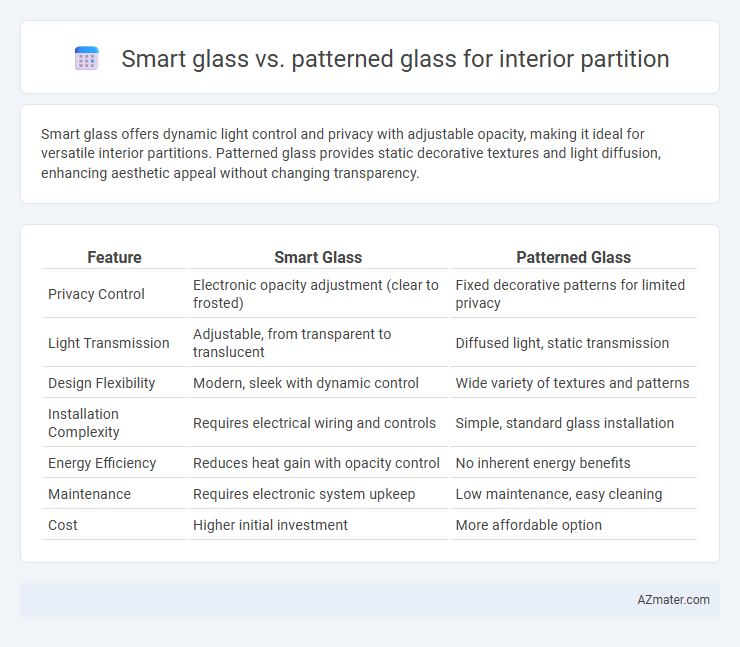Smart glass offers dynamic light control and privacy with adjustable opacity, making it ideal for versatile interior partitions. Patterned glass provides static decorative textures and light diffusion, enhancing aesthetic appeal without changing transparency.
Table of Comparison
| Feature | Smart Glass | Patterned Glass |
|---|---|---|
| Privacy Control | Electronic opacity adjustment (clear to frosted) | Fixed decorative patterns for limited privacy |
| Light Transmission | Adjustable, from transparent to translucent | Diffused light, static transmission |
| Design Flexibility | Modern, sleek with dynamic control | Wide variety of textures and patterns |
| Installation Complexity | Requires electrical wiring and controls | Simple, standard glass installation |
| Energy Efficiency | Reduces heat gain with opacity control | No inherent energy benefits |
| Maintenance | Requires electronic system upkeep | Low maintenance, easy cleaning |
| Cost | Higher initial investment | More affordable option |
Introduction to Interior Glass Partitions
Interior glass partitions enhance space division with transparency and style, offering functional design solutions. Smart glass features switchable opacity for privacy control without sacrificing light, ideal for dynamic environments. Patterned glass provides texture and decorative appeal, creating visual interest while maintaining partial visibility and light diffusion.
What is Smart Glass?
Smart glass, also known as switchable glass, is an innovative material that changes its transparency or opacity when an electric current or heat is applied, allowing privacy control and light modulation within interior partitions. Unlike patterned glass, which is permanently textured or frosted for decoration and partial privacy, smart glass offers dynamic functionality, enabling instant transition between transparent and opaque states to enhance both aesthetic appeal and energy efficiency in office or home interiors. This adaptive feature makes smart glass ideal for modern interior partitions, where flexibility, privacy, and natural light management are crucial.
What is Patterned Glass?
Patterned glass is a type of decorative glass featuring embossed or textured surfaces that provide privacy while allowing light to pass through, making it ideal for interior partitions. Its intricate designs help diffuse light and reduce visibility without compromising brightness, enhancing both aesthetics and functionality. Compared to smart glass, patterned glass offers a permanent, low-maintenance privacy solution without the need for electrical control or temperature sensitivity.
Aesthetic Appeal: Smart Glass vs Patterned Glass
Smart glass offers a sleek, modern aesthetic with its ability to switch between transparent and opaque states, providing dynamic privacy control and minimalist design flexibility. Patterned glass delivers a timeless, decorative element with various textures and motifs that enhance visual interest and complement classic or contemporary interiors. Both options elevate interior partitions, with smart glass emphasizing innovation and versatility, while patterned glass prioritizes artistic detailing and tactile appeal.
Privacy Control Capabilities
Smart glass offers dynamic privacy control through electrochromic or PDLC technology, allowing users to switch between transparent and opaque states instantly, ideal for flexible office environments. Patterned glass provides a fixed level of privacy by incorporating etched, frosted, or textured surfaces that obscure visibility while maintaining natural light diffusion. In terms of adaptability and user control, smart glass significantly outperforms patterned glass by enabling on-demand privacy adjustments without compromising openness or aesthetics.
Light Transmission and Ambiance
Smart glass offers adjustable light transmission, allowing users to control transparency and privacy with a switch, enhancing ambiance versatility in interior partitions. Patterned glass provides consistent light diffusion through textured designs, creating a softer, decorative ambiance while maintaining natural daylight flow. Both options improve light management, with smart glass delivering dynamic control and patterned glass offering fixed aesthetic light transmission qualities.
Installation and Maintenance
Smart glass installation demands specialized electrical wiring and precise integration with control systems, making it more complex and time-consuming compared to patterned glass. Patterned glass offers straightforward installation, similar to standard glazing, requiring minimal tools and expertise. Maintenance for smart glass involves regular checks of electronic components and occasional software updates, while patterned glass requires only routine cleaning and minimal upkeep.
Cost Comparison
Smart glass for interior partitions typically costs between $50 to $150 per square foot, reflecting its advanced technology for switchable opacity and privacy control. Patterned glass, often ranging from $25 to $75 per square foot, offers decorative options at a lower price point but lacks dynamic features. Choosing between smart glass and patterned glass depends on balancing budget constraints with functional requirements for privacy and design flexibility.
Application Scenarios in Modern Interiors
Smart glass offers dynamic light control and privacy, making it ideal for office conference rooms, healthcare facilities, and residential spaces requiring adaptable environments. Patterned glass provides decorative appeal and diffused light, suited for stylish retail stores, hotels, and contemporary homes aiming for aesthetic partitioning without sacrificing illumination. Both materials enhance modern interiors by balancing functionality and design but cater to different needs based on light modulation and visual texture preferences.
Choosing the Right Glass Partition for Your Space
Smart glass offers dynamic opacity control, enabling privacy on demand, energy efficiency, and modern aesthetics, making it ideal for versatile office or residential partitions. Patterned glass provides decorative texture and visual interest, enhancing style while allowing light diffusion but lacks the adjustable privacy features of smart glass. Choosing the right glass partition depends on whether you prioritize adaptability and technology with smart glass or design and classic elegance with patterned glass.

Infographic: Smart glass vs Patterned glass for Interior partition
 azmater.com
azmater.com